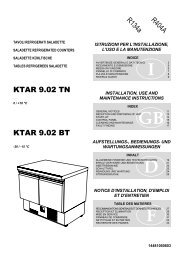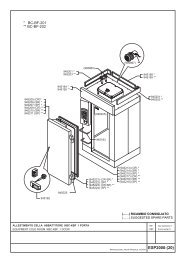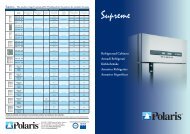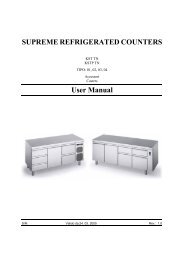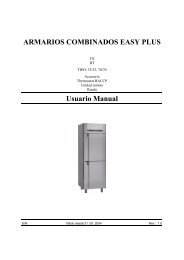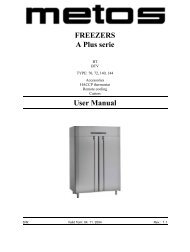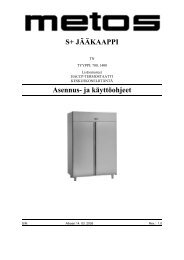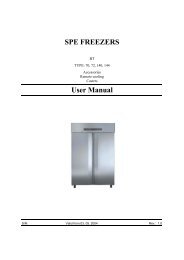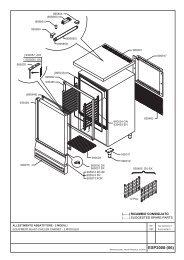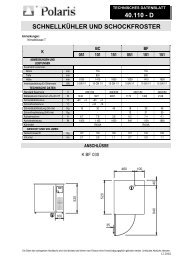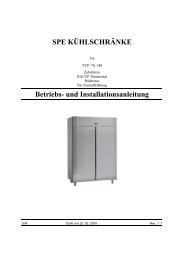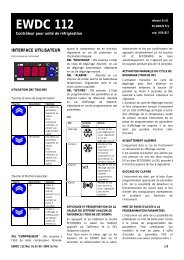gb use and maintenance manual blast chiller/shock freezer
gb use and maintenance manual blast chiller/shock freezer
gb use and maintenance manual blast chiller/shock freezer
Create successful ePaper yourself
Turn your PDF publications into a flip-book with our unique Google optimized e-Paper software.
1.5 BEFORE CONTACTING THE AFTER-SALES SERVICE...Malfunctions are very often ca<strong>use</strong>d by simple problems which the <strong>use</strong>r can solve for himself. Before contactingyour after-sales service, make the following simple checks:A. IF THE APPLIANCE STOPS OPERATING;- check that the plug is fitted into the mains power supply socket correctly.B. IF THE TEMPERATURE INSIDE THE COLD STORAGE APPLIANCE IS NOT LOW ENOUGH;- check that the temperature is not affected by a nearby heat source;- check that the door closes securely.C. IF THE APPLIANCE IS TOO NOISY;- check that the appliance is not in loose contact with any other object.After making the above checks, if the fault persists contact your after-sales service. Remember to specify thefollowing:- the nature of the defect;- the appliance's code <strong>and</strong> serial number, which you will find on its nameplate.1.6 ORDERING SPARE PARTSAlways <strong>use</strong> ORIGINAL SPARE PARTS.The manufacturer declines all responsibility for non original spare parts.2. TECHNICAL DATA2.1 NOISE LEVELLeq in the noisiest point at 1 mt in operating conditionsLpc at 1 mt.in operating conditions< 70 dB(A)< 130 dB(C)TESTING ENVIRONMENTThe test was performed inside a rectangular exposure room without soundproofing treatments. There were nosignificant obstacles in the area around the appliance.REFERENCE STANDARDSThe measurements in the noise level tests were made in accordance with Italian Decree Law n. 277 using theprocedures described in ISO 230-5, in order to collect the data required by EEC directive 89/392.MACHINE OPERATING CONDITIONSThe measurements were made in the most heavy-duty operating conditions, during the start-up phase known as"POOL DOWN".2.2 MATERIALS AND FLUIDS USEDZones in contact with foodstuffs are in AISI 304 stainless steel.These zones are fitted with fan grilles in non toxic plastic, while the metal fasteners <strong>and</strong> supports are in stainlesssteel. The evaporator unit is in copper-aluminium with corrosion-proof paint.The refrigerant units are filled with HCFC or HFC coolant fluid of the type permitted by current legislation.3. OPERATION3.1 APPLICATIONS, INTENDED USE, PROPER AND IMPROPER USE, PERMITTED USESOur cold storage appliances are designed for the storage of foodstuffs (MACHINES DIRECTIVE 89/392).They are designed with all appropriate features to ensure the health <strong>and</strong> safety of <strong>use</strong>rs.How to <strong>use</strong> the <strong>blast</strong> <strong>chiller</strong> <strong>and</strong> the <strong>shock</strong> <strong>freezer</strong>The <strong>blast</strong> <strong>chiller</strong> <strong>and</strong> the <strong>shock</strong> <strong>freezer</strong> are equipments <strong>use</strong>d to quickly lower the temperature of cooked or freshfoods, in order to maintain the organolectyc (chemical-physical <strong>and</strong> nutritional) properties unchanged.Blast chilling cycle:Using this cycle, it is possible to reduce the temperature of cooked food quickly (from +70 to +3°C in 90 minutes) inorder to prevent it from remaining in the critical temperature zone between +10°C <strong>and</strong> +65°C.The coocked, chilled food can be kept in the refrigerator for up to 5 days.15



